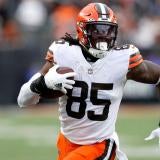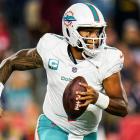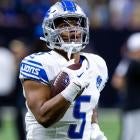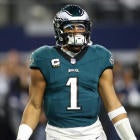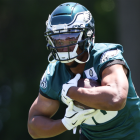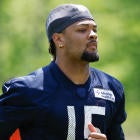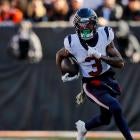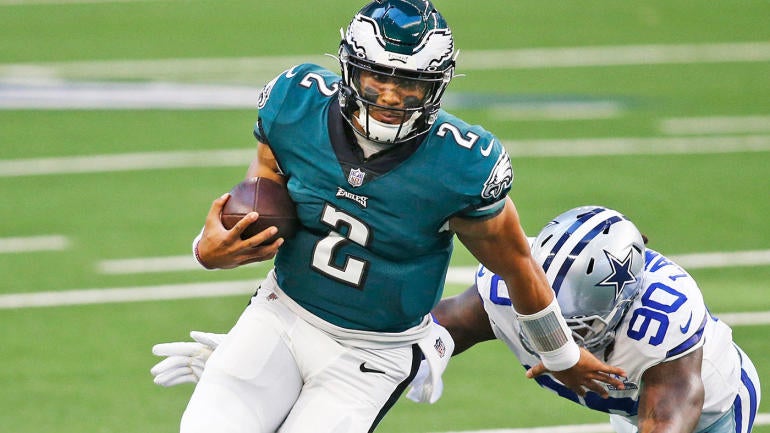
When it comes to setting a Fantasy Football lineup, the matchups are really important. OK fine, maybe not for the stud players who rack up stats each week -- they're starting no matter who they play. But there aren't a lot of those guys. It's the non-obvious guys who we all must make decisions on during the season.
This is my attempt to make some of those decisions now. Before Week 1, before the preseason, and before I even draft a single player.
Every year, I revert to the dark side of Fantasy Football and study every defense. I lean heavily on data such as yards after catch or contact, missed tackles, allowed rush and pass attempts, catch rates, defensive aDOT (or DADOT), blitz and pressure rates and also offensive success rates. But I also evaluate who each team added, who they parted ways with, and how good their starters and bench guys actually are.
When I'm done, I have a grade from 1 to 10 on:
- Every team's pass rush,
- Every team's pass coverage
- Every team's run defense
For quarterbacks, pass rushers and pass coverages are both really important matchup factors. Thusly, I took the pass rush and pass coverage grades, added them together and divided by two to create a cumulative grade. I didn't include run defense grades, and I know some quarterbacks thrive on running the ball, but Fantasy managers correctly ignore run defense matchups for their running quarterbacks.
So now I had an idea of what to expect from each defense this season. I took this grade for each defensive unit and plugged it into each offense's schedule. Each of 17 matchups for every NFL offense now had a grade. I added those grades together to give an informed projection on which teams had easy schedules, and which ones had hard schedules.
Once you get a look at the schedules, you'll see who I believe to be the biggest winners and losers based on who they'll play, and in a few specific cases, when they play them.
How each defense graded out
Here are the final grades for every defense used in the Quarterback Projected Strength of Schedule Rankings (PSoS), with the toughest defense ranked first:
| Team | Grade | Team | Grade |
|---|---|---|---|
| DEN | 9.5 | IND | 6 |
| LAR | 9 | SF | 6 |
| WAS | 9 | LAC | 6 |
| PIT | 8.5 | CHI | 6 |
| TB | 8.5 | SEA | 5 |
| BAL | 8 | NYG | 4.5 |
| KC | 8 | CAR | 4.5 |
| NE | 8 | TEN | 3.5 |
| BUF | 8 | CIN | 3 |
| GB | 7.5 | DAL | 3 |
| MIA | 7.5 | JAC | 3 |
| CLE | 7.5 | LV | 3 |
| NO | 7.5 | NYJ | 2 |
| PHI | 7 | ATL | 2 |
| MIN | 6.5 | DET | 2 |
| ARI | 6 | HOU | 1 |
What the quarterbacks are up against
Here are the Projected Strength of Schedule Rankings for every team for Weeks 1 through 17 (Week 18 isn't included; easiest projected schedule is No. 1 -- the 49ers):
| Rank | Team | Rank | Team |
|---|---|---|---|
| 1 | SF | 16 | PIT |
| 2 | MIA | 18 | TEN |
| 3 | NE | 18 | BUF |
| 4 | JAC | 18 | CHI |
| 5 | IND | 18 | NYJ |
| 6 | DEN | 22 | SEA |
| 7 | LAR | 23 | KC |
| 8 | ARI | 24 | CLE |
| 9 | PHI | 25 | CIN |
| 10 | CAR | 26 | BAL |
| 11 | HOU | 26 | NYG |
| 12 | MIN | 28 | DAL |
| 13 | NO | 29 | LAC |
| 14 | TB | 29 | DET |
| 14 | ATL | 31 | GB |
| 16 | WAS | 32 | LV |
Biggest winners
Jalen Hurts: His top-10 PSoS helps. A fast start against the Falcons, 49ers, Cowboys, Chiefs and Panthers helps a lot. Not only is it OK to draft Hurts as your starting quarterback, but he should be considered a top-10 option.
Trevor Lawrence: Already an incredible prospect settling into a familiar offensive system, Lawrence further benefits from playing in the AFC South and avoiding a lot of tough opponents. To wit, he has one difficult matchup (vs. Denver, Week 2) through his first seven games. He's worth a pick after Round 9, though he's not quite an ideal starter. Lawrence's modest rushing potential and better early slate make him a priority pick ahead of ...
Matthew Stafford: A tough early sked will give way to a mostly bombastic run of opponents that should work out extremely well for the Rams' new passer. You have two routes you can take with him -- let someone else draft him and hope the rough start makes him a buy-low candidate (or a waiver-wire add), or draft him yourself as a terrific bench stash with huge upside.
Trey Lance: Don't hesitate to buy into this guy if he's named the Niners' Week 1 starter. Outside of the Rams, Packers and maybe one other NFC North rival, there's nothing too tough, even for a wide-eyed rookie with minimal college experience. That's exactly part of the recipe this strapping, big-armed passer with rangy rushing tendencies can take advantage of.
Carson Wentz: A bounce-back year cannot happen for Wentz without favorable matchups. Playing the Jaguars, Texans and Titans twice each is a very good start. It remains to be seen if the Colts will let him attempt 36-plus attempts per game like he did last season, but he's got a pretty decent crew along with a great offensive line to help him navigate his way back to Fantasy relevance. Though he's not a must-draft as a speculative No. 2 quarterback, he will be a popular choice in Superflex and two-QB formats.
Tua Tagovailoa: No more excuses. The Dolphins gave him two excellent pass-catchers in Will Fuller and Jaylen Waddle, and their offensive line should be in pretty good shape. Tack on a very favorable schedule (even with the Bills and Patriots on their twice each) and Tagovailoa has every chance to come through for Fantasy managers.
Biggest losers
Justin Herbert: Sophomore slump on deck? Look, his offensive line is in such good shape and his play last year was outstanding until a late-year swoon, so it's hard to say he'll be a straight-up bust. But a schedule finishing in the bottom-5 PSoS definitely doesn't help anything. He'll see the Broncos twice, the Ravens, Steelers, Patriots and Washington once each -- that's six games right there he might underdeliver in. I'll still take him as the seventh quarterback off the board, but consider this fair warning that Herbert may be a little more inconsistent with his fiery games in his sophomore season.
Aaron Rodgers: Let's work under the assumption that Rodgers stays in Green Bay, and that the Packers don't add a receiver to placate him. It's already tough to trust see him passing like he did in 2021, but now we have to process a schedule with the second-worst PSoS in the league. Are we so sure Rodgers is bulletproof from having a season like he did in 2019 when he averaged 19.9 Fantasy points per game? Draft him to be a starter, but don't do it as a top-7 quarterback.
Joe Burrow: Every day, Bengals players, coaches and fans wake up to the reality that they're the worst team in an absolutely loaded AFC North. The Browns improved their pass defense while the Ravens and Steelers boast very strong challenges. Those six matchups alone keep Burrow from becoming a weekly no-brainer must-start. You might be better off letting someone else draft Burrow and then trade for him before Week 8.
Ryan Tannehill: A favorable September slate notwithstanding, Tannehill will go from the fifth-easiest PSoS last year to 14th-toughest. It's not that Tennessee's division rivals are suddenly robust with pass defense talent -- it's that Tennessee is the only AFC South team to play all three of the Steelers, Chiefs and Saints. That's going to be tough for the Titans, whose receiving corps and offensive playcaller have changed. Tannehill is fine to draft late as an early-season quarterback streamer who isn't promised to maintain his consistency once he gets to Week 6.
Matt Ryan: It sure seems like Julio Jones won't be one of Ryan's targets anymore. Combine that with a middle-ranked PSoS and it's hard to see Ryan unloading for numbers close to his 2016 or 2018 seasons. Unless Jones miraculously stays with the Falcons, Ryan is at best a No. 2 Fantasy quarterback with medium upside -- guys like Lawrence and Stafford (and Lance if he's the starter) are all easy players to pick ahead of him.
Daniel Jones: Sure, he got some much-needed help in the passing game this offseason, but his schedule isn't going to help him at all. For instance, he totaled five touchdowns in four games against the Eagles and Washington, and the argument can be made that both of those defensive fronts improved this offseason.


